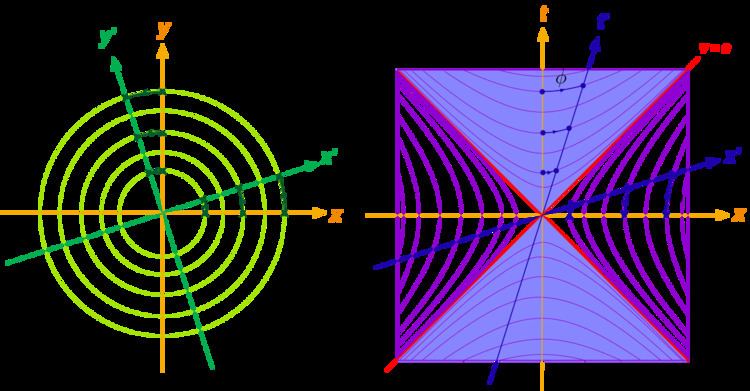 | ||
In plane geometry, two lines are hyperbolic orthogonal when they are reflections of each other over the asymptote of a given hyperbola. Two particular hyperbolas are frequently used in the plane:
The relation of hyperbolic orthogonality actually applies to classes of parallel lines in the plane, where any particular line can represent the class. Thus, for a given hyperbola and asymptote A, a pair of lines (a,b) are hyperbolic orthogonal if there is a pair (c,d) such that
The property of the radius being orthogonal to the tangent at the curve, is extended from the circle to the hyperbola by the hyperbolic orthogonal concept.
Since Hermann Minkowski's foundation for spacetime study in 1908, the concept of points in a spacetime plane being hyperbolic-orthogonal to a timeline (tangent to a world line) has been used to define simultaneity of events relative to the timeline. In Minkowski's development the hyperbola of type (B) above is in use. Two vectors
When c = 1 and the y's and z's are zero, x ≠ 0, t1 ≠ 0, then
A bilinear form is used to describe orthogonality in analytic geometry, with two elements orthogonal when their bilinear form vanishes. In the plane of complex numbers
Given a hyperbola with asymptote A, its reflection in A produces the conjugate hyperbola. Any diameter of the original hyperbola is reflected to a conjugate diameter. The directions indicated by conjugate diameters are taken for space and time axes in relativity. As E. T. Whittaker wrote in 1910, "[the] hyperbola is unaltered when any pair of conjugate diameters are taken as new axes, and a new unit of length is taken proportional to the length of either of these diameters." On this principle of relativity, he then wrote the Lorentz transformation in the modern form using rapidity.
Edwin Bidwell Wilson and Gilbert N. Lewis developed the concept within synthetic geometry in 1912. They note "in our plane no pair of perpendicular [hyperbolic-orthogonal] lines is better suited to serve as coordinate axes than any other pair"
The notion of hyperbolic orthogonality arose in analytic geometry in consideration of conjugate diameters of ellipses and hyperbolas. if g and g′ represent the slopes of the conjugate diameters, then
In the terminology of projective geometry, the operation of taking the hyperbolic orthogonal line is a involution. Suppose the slope of a vertical line is denoted ∞ so that all lines have a slope in the projectively extended real line. Then whichever hyperbola (A) or (B) is used, the operation is an example of a hyperbolic involution where the asymptote is invariant.
